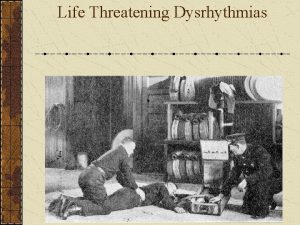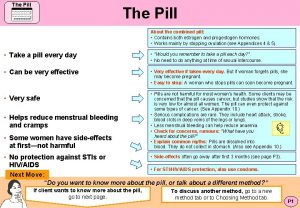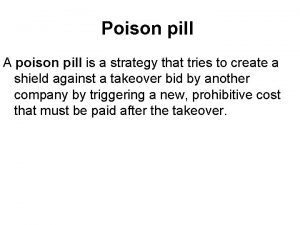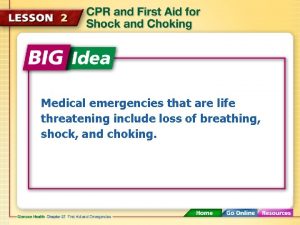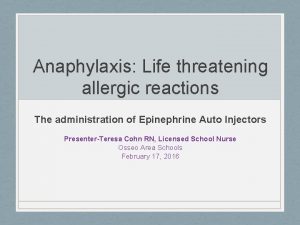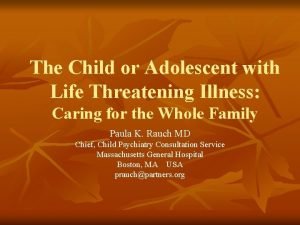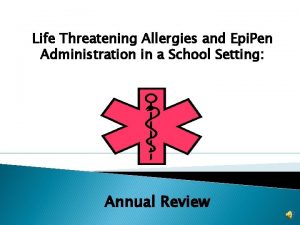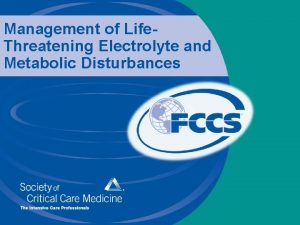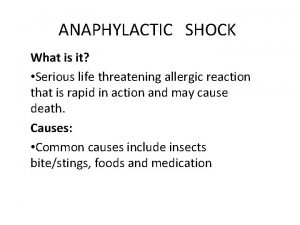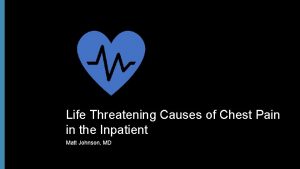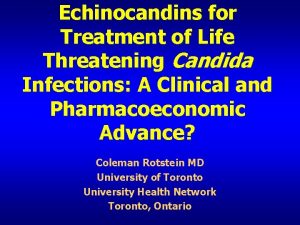THE PILL KILLS The Life Threatening Medical Consequences

























- Slides: 25

THE PILL KILLS The Life Threatening Medical Consequences of Oral Contraceptives A. K. A. estrogen-progestin combination drugs Angela Lanfranchi, M. D. , F. A. C. S. Surgical Co-director sanofi aventis Breast Care Center at Steeplechase Cancer Center Clinical Assistant Professor of Surgery Robert Wood Johnson Medical School

If the Pill is so bad, why do teenagers love it? They get bigger breasts They have lighter periods They have predictable periods They have painless periods They improve their complexion They think they don’t have to worry about pregnancy if they give in or slip up

If the pill is so bad, why do their parents love it? Parents think the pill will keep their kids from getting pregnant Parents will worry less Parents possess the strong defense mechanism of denial - “it’s for acne” or “it’s for painful periods” Parents think it makes their kids “responsible” if they choose to have sex Parents don’t know the medical risks

How the PILL KILLS The Four Major Mechanisms They cause your blood to clot They cause cancer They make it easier to get potentially lethal infections They make it more likely you will die a violent death

They Make Your Blood Clot Blood clots in a heart artery cause a heart attack (MI) Blood clots in a brain artery cause a stroke (CVA) Blood clots in your leg veins cause deep venous thrombosis (DVT). And blood clots, that break off from the legs and go to the lungs, can cause a fatal pulmonary embolism (PE) and is known as venous thromboembolism (VTE).

They Make Your Blood Clot MI Women who use the Pill have twice the risk of MI Women with no conventional risk factors (hypertension, hypercholesterolemia, diabetes, or smoking) who used oral contraceptives had a relative risk of myocardial infarction of 2. 0 (95 percent confidence interval, 1. 5 to 2. 8). The duration of oral-contraceptive use did not differ significantly between patients and controls (median, 10 years). Tanis, BC et al Oral Contraceptives and the risk of myocardial infarction, NEJM 2001; 345: 1787 -1793

They Make Your Blood Clot MI Among women who had used oral contraceptives, the risk of myocardial infarction was highest among: Those with hypertension (odds ratio 6. 1) or 5 times the risk Those who smoked (odds ratio, 13. 6), or 12 times the risk Those who had diabetes (odds ratio, 17. 4), or 16 times the risk And those who had hypercholesterolemia (odds ratio, 24. 7) or 23 times the risk

They Make Your Blood Clot CVA There is over twice the risk of stroke in women on the Pill By a meta-analysis which combined the results of 16 studies, there was a relative risk of 2. 75 ( 2. 24 -3. 38) or near 3 times the risk of ischemic stroke. The risk is even higher with other risk factors But for women who take birth control pills and smoke, have high blood pressure or have a history of migraine headaches, the stroke risk is significantly higher Gillum, LA Ischemic stroke risk with oral contraceptives JAMA July 5 2000; 284: 72 -78

They Make Your Blood Clot Pulmonary embolism PE ( > 90% from leg clots DVT ) Venous Thromboembolism VTE There is two to three times the risk of pulmonary embolism in women on the Pill VTE In total, 4, 213 venous thrombotic events were observed, 2, 045 in current users of oral contraceptives. The overall absolute risk of venous thrombosis per 10, 000 woman years in non-users of oral contraceptives was 3. 01 and in current users was 6. 29. Compared with non-users of combined oral contraceptives, the ratio of venous thrombembolism in current users decreased with duration of use (<1 year 4. 17, 95% confidence interval 3. 73 to 4. 66, 1 -4 years 2. 98, 2. 73 to 3. 26, and >4 years 2. 76, 2. 53 to 3. 02; P<0. 001) and with decreasing dose of oestrogen. Lindegaard, O et al Risk of venous thromboembolism from use of oral contraceptives containing different progestogens and oestrogens Danish cohort study 2001 -9 BMJ 2011 343: d 6423

They Make Your Blood Clot Pulmonary embolism PE ( > 90% from leg clots DVT ) Venous Thromboembolism VTE Pills with androgenic progestins have an additional 60 -80% risk of VTE Compared with oral contraceptives containing levonorgestrel, those with: desogestrel 1. 82 (1. 49 to 2. 22), gestodene 1. 86 (1. 59 to 2. 18), drospirenone 1. 64 (1. 27 to 2. 10), with cyproterone 1. 88 (1. 47 to 2. 42). (eg. Yaz and Yasmin)

They Make Your Blood Clot Pulmonary embolism PE ( > 90% from leg clots DVT ) Venous Thromboembolism VTE The Patch causes estrogen to be 60% higher than the Pill and greatly increases all clotting. Women with hereditary conditions that cause clotting (protein C & S deficiency, antithrombin III def. , Factor V Leyiden def. ) have even higher rates of VTE

They cause cancer BREAST In 2000, the National Toxicology Advisory Panel put estrogen on its list of carcinogens. There are metabolites of estrogen which directly damage DNA causing mutations and cancer. In 2005, the UN’s International Agency on Research of Cancer (IARC) reported in their Monograph 91 that estrogen-progestin combination drugs (the Pill) was a group 1 carcinogen for breast, cervical and liver cancer. Although the risk of uterine and ovarian cancers were lower on the pill, there is 6 times more breast cancer in women than uterine and ovarian cancers combined.

They cause cancer BREAST In 2006, Kahlenborn’s meta-analysis in the Mayo Clinic Proceedings showed a 44% increase risk of breast cancer in women who took the Pill before having a child. In 2009, Dolle in Cancer Epidemiology and Biomarkers and Prevention showed a 320% increase risk of triple negative breast cancer Since 1975, the risk of in-situ breast cancer has increased 400% in premenopausal women Kahlenborn, C et al Oral contraceptive use as a rsik factor for premenopausal breast cancer: A meta-analysis 2006 Mayo Clinic Proc 2006 81(10): 1290 -1302 Dolle, J et al Risk factors for triple negative breast cancer in women under the age of 45 cancer Epidemiol Biomarkers Preve 2009; 18(4) 1157 -1165

They cause cancer CERVICAL The risk of cervical cancer does increase with more than five years of the Pill Women who use the OCPs for five to nine years have twice the risk of cervical cancer OR 2. 82 (1. 46 -5. 42) Women who use the OCPs for 10 years or more have more than a three times risk of cervical cancer OR 4. 03 ( 2. 09 -8. 02). Moreno V et al Effect of oral contraceptives on risk of cervical Cancer in women with HPV infection: the IARC multicentric case control study Lancet 2002 Mar 30; 359(9312): 1085 -92

They cause cancer LIVER Primary liver cancer (hepatocellular carcinoma) is rare in developed countries and the pill increases risk over 50 -70% in women. The evidence of OC and liver cancer is based on at least 12 case– control studies, including 739 cases and 5223 controls, which were reviewed in a meta-analysis. The overall RR was 1. 57 (95% CI: 0. 96– 2. 54), with some evidence of duration-risk association in six studies. Exclusion of a recent multinational European study increased the pooled RR to 1. 70 (95% to 1. 12– 2. 59) and decreased heterogeneity. The association is less strong in studies from developing countries, where hepatitis B and C infections are more common. The pill also increases the risk of benign tumors, hepatic adenomas. The pill increases the risk of focal nodular hyperplasia (FNH) of the liver. IARC 2005 Monograph 91

More likely to develop lethal infections Women on the pill increased their risk 60% to get HIV infection when compared to women not taking the pill. Women on the pill were twice as likely to transmit HIV to their partner. Women on the pill were twice as likely to get infected with HPV (human papilloma virus) Wang, C C et al Rsik of HIV infection in oral contraceptive pill users: a metaanalysis JAIDS 1999 May 1 21 (1) : 51 -58 Franceschi, S et al Genital warts and cervical neoplasia: an Epidemiological study Br J Cancer 1983; 48: 621 -628

More likely to die a violent death The Walnut Creek Contraceptive Study Prospective study of the side effects of oral contraceptives Journal of Reproductive Medicine December 1980 Chapter 9 Mortality The major causes of death were: ‣ malignant neoplasms (45%) ‣ accidents or violence (19%) ‣ cardiovascular diseases (15%)

More likely to die a violent death Mortality among contraceptive pill users: cohort evidence from Royal College of General Practitioners’ Oral Contraception Study BMJ 2010 Results 1, 747 deaths occurred in never users of oral contraception and 2, 864 in ever users. Compared with never users, ever users of oral contraception had a significantly lower rate of death from any cause (adjusted relative risk 0. 88, 95% confidence interval 0. 82 to 0. 93). They also had significantly lower rates of death from all cancers; large bowel/rectum, uterine body, and ovarian cancer; main gynaecological cancers combined; all circulatory disease; ischaemic heart disease; and all other diseases. They had higher rates of violent deaths. No association between overall mortality and duration of oral contraceptive use was observed, although some disease specific relations were apparent. An increased relative risk of death from any cause between ever users and never users was observed in women aged under 45 years who had stopped using oral contraceptives 5 -9 years previously but not in those with more distant use. The estimated absolute reduction in all cause mortality among ever users of oral contraception was 52 per 100, 000 woman years.

More likely to die a violent death The Whys of why violent death more likely S. Craig Roberts, 13 March 2010 Senior Lecturer School of Biological Sciences, University of Liverpool, Liverpool L 69 7 ZB Hannahford et al. (2010) report convincing evidence for reduction in mortality from several forms of cancer and other disease in women who have used oral contraception compared to never users. However, they also find a higher rate of violent death among ever users, and that the rate of violent death increases with longer duration of oral contraceptive use, but they are unable to explain these intriguing results. I suggest that recent evolutionary insights into human partner choice may provide a clue.

More likely to die a violent death There is evidence that use of oral contraception alters women’s baseline preferences for men such that pill users prefer men who are relatively similar to themselves at loci in the major histocompatibility complex (MHC). One consequence of being partnered with relatively MHC-similar men is that such women • express lower sexual responsivity toward their long-term partner compared with women in relatively MHC-dissimilar couples • reject sexual advances from their partner more frequently • and report having had more extra-pair partners[4]. In others words : Bad sex, less sex and cheating lead to VIOLENCE.

More likely to die a violent death Other evidence points to MHC-similar couples being more likely to experience problems conceiving children, and having less healthy children due to lower MHC-heterozygosity. Cumulatively, these effects could have real impact on the quality of spousal relationships.

More likely to die a violent death It is not unreasonable to suspect that such effects could also influence rates of intimate partner violence. This is the most common cause of nonfatal injury among women and accounts for more than a third of women murdered in the US. Furthermore, ex-partners are a key risk factor, which could further emphasize the risk for pill users if the behavioral effects of pill use ultimately influence rates of marital breakdown (No doubt a reason for the fact the greatest cause of death of pregnant women is homicide. ) Kellermann AL, Mercy JA (1992) Men, women and murder: genderspecific differences in rates of fatal violence and victimization. Journal of Trauma 33: 1 -5.

The pill is also an abortifacient As is well observed by those on the pill, menstrual periods are light because the pill reduces the thickness of the endometrial lining, resulting in difficulty of implantation of the embryo after conception has occurred. The pill also results in biochemical changes such as in the levels of interleukins, which are molecules necessary for implantation. Wilks, J The impact of the pill Ethics and Medicine 2000 ; 16(1): 15 -22

THE PROBLEM IS HUGE There approximately 75 million women of reproductive age (15 -45 years old). 82% of these women take the Pill. Women on THE PILL are more likely to have an MI, a CVA, a PE, get breast, cervical and liver cancers, get HIV and HPV infections and die a violent death. Is this what we want for young women ? ? THE PILL KILLS

1 -866 -622 -6237 (1 -86 NO CANCER) www. bcpinstitute. org Copyright 2012, all rights reserved. 25
 Smoking kills
Smoking kills Who kills macbeth?
Who kills macbeth? He makes the men feel they should hate banquo.
He makes the men feel they should hate banquo. What are the themes of hamlet
What are the themes of hamlet Great kills high school
Great kills high school Testimonials synonym
Testimonials synonym David killing a bear
David killing a bear Cold water kills
Cold water kills A bird stalks kills and then eats an insect
A bird stalks kills and then eats an insect A bird stalks kills then eats
A bird stalks kills then eats Who sends romeo into exile
Who sends romeo into exile What is non threatening body language
What is non threatening body language Chapter 7 learning goals outline sociology
Chapter 7 learning goals outline sociology Threating face
Threating face Non threatening body language
Non threatening body language What is non threatening body language
What is non threatening body language Primary deviance definition
Primary deviance definition Fie fie unknit that threatening unkind brow
Fie fie unknit that threatening unkind brow Blue pill attack
Blue pill attack Pelan intervensi 5 langkah
Pelan intervensi 5 langkah What is a poison pill defense
What is a poison pill defense Aboerion pill
Aboerion pill Pill camera introduction
Pill camera introduction Micro electronic pill research paper
Micro electronic pill research paper Red pill test
Red pill test Isehelisev löökpill
Isehelisev löökpill


























